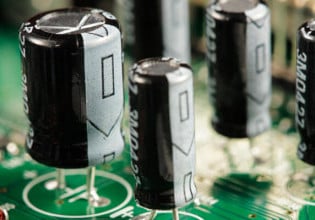Battery Monitor for High- and Low-Voltage Battery Modules
Maxim Integrated introduced the MAX17853, a data-acquisition system for the management of high-voltage and low-voltage battery modules. In 263µs, the system can measure 14 cell voltages and a combination of six temperatures or system voltage measurements with fully redundant measurement engines, or it can perform all inputs solely with the ADC measurement engine in 156µs.
Typical applications for the battery monitor include battery-backup systems (UPS), battery-powered tools, electric bikes,
EVs, high-voltage battery stacks, hybrid electric vehicles (HEVs), and super-cap systems.
The battery monitor features 14 internal balancing switches rated for >300mA for cell-balancing current, each supporting extensive built-in diagnostics. Up to 32 devices can be daisy-chained to monitor 192 temperatures and manage 448 cells.
Cell and bus-bar voltages ranging from -2.5V to +5V are measured differentially over a 65V common-mode range, with a typical accuracy of 1mV (3.6V cell, 25°C). The device comes in a 64-pin LQFN package.
If oversampling is enabled, the battery monitor can average up to 128 measurements per channel internally with 14-bit resolution. Oversampling also enables digital post-processing IIR filtering for increased noise immunity.
In the event of a thermal overload, the system can shut itself down by measuring its own die temperature.
For robust communications, the system employs a Maxim battery-management UART or SPI protocol, and the company optimized it to support a reduced feature set of internal diagnostics and rapid-alert communication through both embedded communication and hardware-alert interfaces to support ASIL D and FMEA requirements.
The device offers automatic thermal protection and offers individually configurable safety alerts. MAX17853 detects over-voltage, under-temperature faults as well as under-voltage, over-temperature faults.
Key Features
- 65V Operating Voltage
- Ultra-Low-Power Operation
- Standby Mode: 2mA
- Shutdown Mode: 2µA
- Redundant ADC and Comparator (COMP) Acquisitions
- Simultaneous Cell and Bus-Bar Voltage Acquisitions
- 14 Cell-Voltage Measurement Channels
- 1mV Accuracy (3.6V, 25°C)
- 2mV (Max) Accuracy (5°C to 40°C)
- 4.5mV (Max) Accuracy (-40°C to +105°C)
- 14 Cell-Balancing Switches
- >300mA Software-Programmable Balancing Current
- Optimized Driving and Parking Balancing Modes
- Automated Balancing with Individual Cell Timers
- Automated Balancing by Cell Voltage
- Emergency Discharge Mode
- Six Configurable Auxiliary Inputs for Temperature, Voltage, or GPIO
- Integrated Die-Temperature Measurement
- Automatic Thermal Protection
- Individually Configurable Safety Alert
- Over-voltage, Under-temperature Faults
- Under-voltage, Over-temperature Faults
- One Cell-Mismatch Alert
- Support ASIL D Requirements for Cell Voltage, Temperature,
- Communication
- Selectable UART, Dual UART, or SPI Interface
- Battery-Management UART Protocol
- Daisy-Chain Up to 32 Devices
- Capacitive Communication-Port Isolation
- Up to 2Mps Baud Rate (auto-detect)
- 1.5μs Propagation Delay (per device)
- Packet-Error Checking (PEC)
- Configurable Hardware-Alert Interfaces
- Factory-Trimmed Oscillator
- No External Crystals Required
- 32-Bit Unique Device ID
- 64-Pin (10mm x 10mm) LQFP Package






